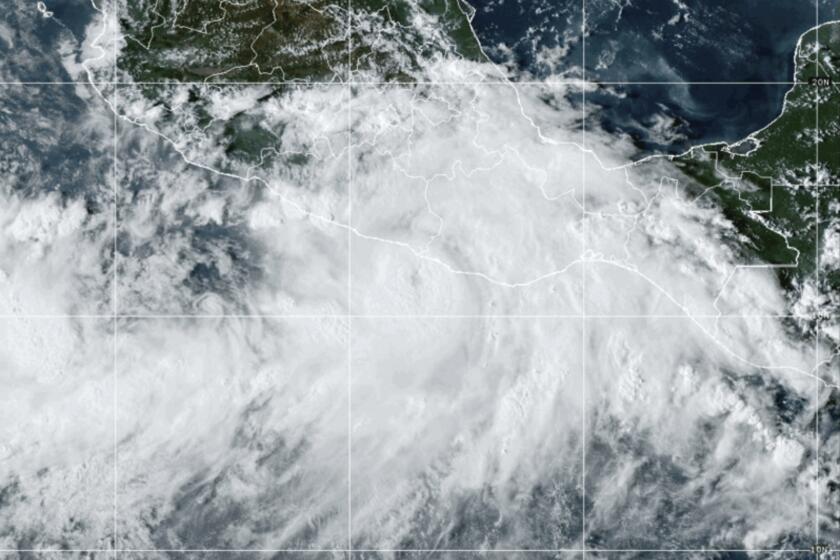Lush River Struggles to Survive
The San Pedro has been a life-giving river for thousands of years, archeologists believe, its lush banks providing a desert refuge for travelers since Francisco Vasquez de Coronado passed by in 1540 on his quest for the seven cities of gold.
Today, however, the Spanish explorer would find the San Pedro’s welcome wearing thin. Renowned for its wealth of wildlife and as one of the Southwest’s last free-flowing rivers, the San Pedro has begun to dry up.
Last month, a measuring instrument placed at the river’s high-water mark failed to register any flow for the first time in 70 years.
“When the water goes at the Charleston gauge, it’s the last bastion, so to speak,” said Tom Maddock, head of the University of Arizona’s Department of Hydrology and Water Resources in Tucson. “My feeling is that we are just watching the demise of another river system. We might be able to save it for a while, but this river is going to go.”
Until now, the gauge, just east of Sierra Vista, had marked the deepest, lushest section of the river.
Flowing through a southern Arizona region that averages 16 inches of rainfall a year, the 140-mile-long river corridor sustains the second-largest concentration of mammals in the world, behind Costa Rica. It also supports 43 species of reptiles and amphibians, as well as millions of birds. It is one of the few places in the country where jaguars have been seen in the last century.
Scientists say several natural factors play a role in the San Pedro’s predicament, including a prolonged drought, the hottest July on record and even the thirst of the riparian area’s massive galleries of trees.
But the biggest water use in this section of river -- about 25 miles north of the Mexican border -- is the ever-increasing groundwater pumping that draws from an aquifer that is a key source of supply for the river.
Much of the water is diverted to scattered ranches for agriculture and livestock. More goes to the town of Sierra Vista and the Army’s Ft. Huachuca, two of the largest water users in southeast Arizona. The same aquifer is also depleted by as many as 3,000 unregulated private wells that are not governed by the state’s water laws.
Even in normal years, the entire length of the undammed San Pedro has an intermittent flow, and stretches rely, in part, on late summer monsoon rains to refill it. But the river also depends on the aquifer and has little hope of rejuvenating without the flow.
Hydrologists and conservationists have warned for many years that increased water use endangered the river. Now that the wettest stretch of the river has gone dry, experts warn that the trees lining the river could start dying off in a few years, which would deprive dependent wildlife of shelter and food.
“It’s a critical migration corridor, and if it were to go away, there’s no real alternative in the region,” said Scott Wilbor, an avian biologist with the Tucson Audubon Society. “It’s a stronghold for certain species like the yellow warbler and the yellow-billed cuckoo. It’s critical. I’m not just speaking for myself as an avian biologist. We know that there’s no replacing it.”
From its headwaters in the Mariquita and Elenita mountain ranges in northern Mexico, the San Pedro slices into the United States about 40 miles east of Nogales. The slow-moving river heads north, flanked by 50-foot Fremont cottonwoods and Goodding’s willows that rise above anything that can be seen on the horizon for miles. A green ribbon in the brown desert, the San Pedro is a trusted landmark for low-flying aircraft in a region otherwise devoid of distinguishing features.
The federal Bureau of Land Management has managed the San Pedro and its immediate environs since 1988, when the river was designated a National Riparian Conservation Area. It was the nation’s first river corridor to be set aside for protection.
The law gives the agency broad powers to prevent physical damage to the river and protect it from trespassing, mining, grazing and destruction from off-road vehicles. The land bureau does not, however, have the right to dictate water use in the region, even to keep the river from drying up. Though the agency has reintroduced beavers to dam portions of the river and hold pockets of water in ponds, it cannot turn off the taps in nearby towns.
The challenge for the bureau and others concerned about the San Pedro is not just maintaining minimal flows but retaining enough water to nourish the lush vegetation that is the river’s most distinguishing feature.
On a recent tour, Bill Childress, the BLM’s riparian area manager, led the way under the cool canopy of cottonwoods, ash and walnut, and pointed out a beaver pond maintained by the recently reintroduced mammal. But even the ponds are vulnerable to draining as water is pumped from the aquifer.
The San Pedro was the first site in the Western Hemisphere to be designated by the American Bird Conservancy, Partners in Flight and the National Audubon Society as a Globally Important Bird Area. It is home to nearly 400 species of birds, and two-thirds of the nation’s birds spend part of the year here.
The riparian area, which in some places is 5 miles wide, plays host to some 4 million migrating songbirds, which move from their wintering grounds in Mexico and Central America to breeding grounds in the United States and Canada.
Bird watching, America’s most popular pastime, brings in $28 million to this area annually, and bed and breakfasts and small inns feature bird names and themes.
“You’d be hard pressed to find another riparian corridor that supports such an amazing assembly of native species, especially in the desert Southwest,” said Holly Richter of the Nature Conservancy, a nonprofit organization that assists the bureau in managing the conservation area.
The San Pedro’s water levels are closely monitored by local and state officials in fast-growing Cochise County. Less water in the region may lead to limits on growth and cutbacks in residential water use, as has been the case in other communities in the Southwest.
Hydrologists say the present draw-down has caused water levels in the aquifer to drop hundreds of feet. One study 10 years ago found that Sierra Vista’s pumping had depleted portions of the underground reservoir to such an extent that the town was pulling its water directly from the river. City officials disputed the findings and funded another study that came to a less worrisome conclusion.
Sierra Vista is a bustling community populated with retirees and employees from Ft. Huachuca. The town of 40,000 has been growing at a 7% rate since 2000. Plans are in the offing for an 8,500-home subdivision.
Officials are studying the feasibility of using other water sources, including pumping from long-abandoned silver mines in Tombstone and copper mines in Bisbee.
The U.S. Bureau of Reclamation is expected to release a report about the San Pedro this fall, providing some scientific measurements, but its calculation will leave it to others to solve the problem.
“The canary in the coal mine is dead,” said Robin Silver of the Center for Biological Diversity, an environmental group. “It’s not a question of ‘Are we having a problem?’ This is a question of ‘When are those who are responsible going to be responsible?’ The answer is, ‘Not yet.’ ”
More to Read
Sign up for Essential California
The most important California stories and recommendations in your inbox every morning.
You may occasionally receive promotional content from the Los Angeles Times.











